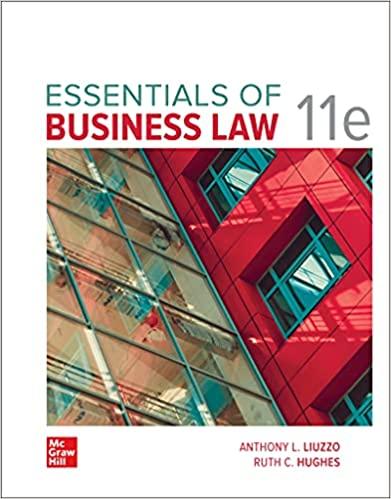Question
Read the case above.Please talk about whether or not you agree with the ruling. Note there are two points made at the end explaining why
Read the case above.Please talk about whether or not you agree with the ruling. Note there are two points made at the end explaining why the beer company is innocent.Do you agree?
LINK:https://www.leagle.com/decision/1994464205michapp2591441
TITLE:OVERTON v. ANHEUSER-BUSCH CO.
(If you can't open the link here is the article)
205 Mich. App. 259 (1994)
517 N.W.2d 308
OVERTON v. ANHEUSER-BUSCH COMPANY
Michigan Court of Appeals.
Submitted November 10, 1993, at Grand Rapids.
Decided May 16, 1994, at 9:10 A.M.
Attorney(s) appearing for the Case
Richard Overton, in propria persona.
Kelly L. Page,andSkadden, Arps, Slate, Meagher & Flom(byMatthew M. Neumeier), for the defendant.
Before: McDONALD, P.J., and MURPHY and TAYLOR, JJ.
[205 Mich. App. 260]
TAYLOR, J.Plaintiff appeals as of right the circuit court order granting summary disposition to defendant and dismissing plaintiff's complaint, filed in propria persona, for declaratory relief, injunctive relief, and money damages under Michigan's pricing and advertising act (PAA), MCL 445.351et seq.; MSA 19.853(11)et seq.We affirm.
On June 6, 1991, plaintiff sued defendant, a brewer and seller of beer and malt liquor, claiming that defendant had violated the provisions of the PAA by placing before the public advertisements for its products that contain "statements and/or representations which are untrue, deceptive and/or misleading." As a result, plaintiff claimed, he and the general public had been led to consume defendant's products, which defendant knew were dangerous and likely to cause serious health problems, including addiction and death. In support of his claims, plaintiff pointed to defendant's television advertisements featuring Bud Light as the source of fantasies coming to life, fantasies involving tropical settings, and beautiful women and men engaged in unrestricted merriment. Plaintiff sought monetary damages in excess of $10,000, alleging that defendant's misleading advertisements had caused him physical and mental injury, emotional distress, and financial loss.
Defendant moved for summary disposition, arguing among other things that it had no duty to warn of commonly known dangers. The trial court agreed with defendant's analysis in this regard, and granted summary disposition in its favor. We agree and affirm.
The PAA regulates the pricing and advertising of consumer items. It prohibits placing before the public an advertisement that contains a statement or representation that is untrue, deceptive, or misleading. MCL 445.356(1); MSA 19.853(16)(1).
[205 Mich. App. 261]
The act provides that, in determining whether advertising is deceptive or misleading, the extent to which the advertising fails to reveal facts that are material in light of the representations made or suggested in a positive manner shall be taken into account. MCL 445.356(3); MSA 19.853(16)(3). This Court has previously held that the PAA is to be construed with reference to the common-law tort of fraud.Mayhall v A H Pond Co, Inc,129 Mich.App. 178, 182;341 N.W.2d 268(1983).Here, plaintiff has made a two-pronged attack. First, he asserts that defendant's advertising is deceptive and misleading because it falsely suggests that defendant's beer is the source of fantasies come to life. Such a grandiose suggestion constitutes puffing, which does not give rise to actionable fraud.Van Tassel v McDonald Corp,159 Mich.App. 745, 750;407 N.W.2d 6(1987). Second, plaintiff asserts that the advertising is deceptive and misleading because it portrays beer in a positive light only, without reference to the dangers inherent in the consumption of alcoholic beverages, i.e., omits a material fact. Concealing a fact that one is bound to disclose is an indirect representation that such fact does not exist and constitutes fraud under the common law.United States Fidelity & Guaranty Co v Black,412 Mich. 99, 125;313 N.W.2d 77(1981);In re People v Jory,443 Mich. 403, 416;505 N.W.2d 228(1993). Further, subsections 6(1) and (3) of the PAA create statutory duty to disclose material facts. The question whether a duty exists is one of law for the courts to decide.Moning v Alfono,400 Mich. 425, 436-437;254 N.W.2d 759(1977). Questions of law are reviewed de novo.Cardinal Mooney High School v Michigan High School Athletic Ass'n,437 Mich. 75, 80;467 N.W.2d 21(1991).
We conclude that defendant has no duty under
[205 Mich. App. 262]
the PAA or the common law to disclose the dangers inherent in the consumption of beer. Our Supreme Court has long recognized that the dangers inherent in alcohol consumption are well known to the public.People v Hoy,380 Mich. 597, 604;158 N.W.2d 436(1968);Gaines v Sun Life Assurance Co of Canada,306 Mich. 192, 201; 10 N.W.2d 823 (1943); cert den 321 U.S. 789 (1944);Hemington v Hemington,221 Mich. 206, 209; 190 NW 627 (1922), overruled on other grounds inFelgner v Anderson,375 Mich. 23, 56-57;133 N.W.2d 136(1965). Because the dangers inherent in the consumption of beer are well known to the general public, nothing material was concealed. Defendant had no duty under the common law or 6 of the PAA to "disclose" in its advertisements damages that are already well known.Therefore, summary disposition was properly granted to defendant on plaintiff's failure to state a claim upon which relief could be granted. MCR 2.116(C)(8);Radke v Everett,442 Mich. 368, 373-374;501 N.W.2d 155(1993).
Step by Step Solution
There are 3 Steps involved in it
Step: 1

Get Instant Access to Expert-Tailored Solutions
See step-by-step solutions with expert insights and AI powered tools for academic success
Step: 2

Step: 3

Ace Your Homework with AI
Get the answers you need in no time with our AI-driven, step-by-step assistance
Get Started


